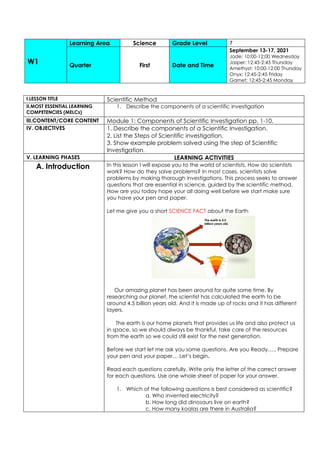
LE G7 Sci Q1W1.pdf
- 1. W1 Learning Area Science Grade Level 7 Quarter First Date and Time September 13-17, 2021 Jade: 10:00-12:00 Wednesday Jasper: 12:45-2:45 Thursday Amethyst: 10:00-12:00 Thursday Onyx: 12:45-2:45 Friday Garnet: 12:45-2:45 Monday I.LESSON TITLE Scientific Method II.MOST ESSENTIAL LEARNING COMPETENCIES (MELCs) 1. Describe the components of a scientific investigation III.CONTENT/CORE CONTENT Module 1: Components of Scientific Investigation pp. 1-10. IV. OBJECTIVES 1. Describe the components of a Scientific Investigation. 2. List the Steps of Scientific investigation. 3. Show example problem solved using the step of Scientific Investigation. V. LEARNING PHASES LEARNING ACTIVITIES A. Introduction In this lesson I will expose you to the world of scientists. How do scientists work? How do they solve problems? In most cases, scientists solve problems by making thorough investigations. This process seeks to answer questions that are essential in science, guided by the scientific method. How are you today hope your all doing well before we start make sure you have your pen and paper. Let me give you a short SCIENCE FACT about the Earth Our amazing planet has been around for quite some time. By researching our planet, the scientist has calculated the earth to be around 4.5 billion years old. And it is made up of rocks and it has different layers. The earth is our home planets that provides us life and also protect us in space, so we should always be thankful, take care of the resources from the earth so we could still exist for the next generation. Before we start let me ask you some questions. Are you Ready….. Prepare your pen and your paper… Let’s begin. Read each questions carefully. Write only the letter of the correct answer for each questions. Use one whole sheet of paper for your answer. 1. Which of the following questions is best considered as scientific? a. Who invented electricity? b. How long did dinosaurs live on earth? c. How many koalas are there in Australia?
- 2. d. Does the amount of salt in water affect the temperature at which it boils? 2.What is the process of obtaining information using your senses? a. Inquiry b. Conclusion c. Observation d. Scientific Method 3. What is the series of steps to designed to help you solve problems and answer questions? a. Inquiry b. Surveys c. Interview d. Scientific Method 4. In which step of the scientific method do we use graphs? a. Analyze data c. Making hypothesis b. Asking question d. Communicating results 5. When a scientist shares his findings with other scientist, he is ______. a. Experimenting c. Making a hypothesis b. Analyzing data d. Communicating the results B. Development LESSON There you go…. now let me ask you this… How do you usually solve your problem or answer a questions, In my case what I do is I analyze a problem at hand and think of a possible solution if it is effective or not. For now, let us explore the step of the Scientific Method. Are you ready, that’s great all we have to do is to understand the selection that you will see, let start
- 3. Scientific Method is used to arrive for the right answer to your questions. Science is a way of thinking and a way of gathering knowledge about the world that is both accurate and reliable. It is the quest to understand and improve our knowledge of the world around us, and how the things in it work or why they work the way they do. Scientific Method is a series of step designs help to solve your problems and answer questions. Lets’ elaborate the step of scientific method. C. Engagement You will now be analyzing the situation by determining the components of scientific investigation. A systematic method of solving problems around us Learning Task No. 1: Refer to the given data inside column A. Write possible problems based on the given data. Choose the at least 3
- 4. available data that will support your answer from the choices in column B. Write your answer in a separate sheet of paper. Refer to your modules p.8 Learning Task No. 2: A hypothesis is not simply a guess! A hypothesis is an educated guess or tentative answer to a problem. The student thinks that ice will melt faster in juice than it will in water. Maybe he just wants to get a drink of juice out of it. Examples: 1. What happens to the growth of mongo seeds if table salt was added to the soil? 2. Tomato seeds may grow faster in colder temperature. Hypothesis: 1. If the amount of salt added to the soil increases, then the growth of mongo seeds decreases. 2. If tomato seeds were planted in colder temperature, then the seeds will grow at a faster rate. Let’s Try This 1. What effect does temperature have on the dissolution rate of sugar in water? Hypothesis: _____________________________________________________ 2. Eating chocolates may cause pimples. Hypothesis: _____________________________________________________ D. Assimilation What I Have Learned Now that your Scientific Method is clear let’s have an assessment. Now the Scientific Method is given. Match the corresponding description for each step given. Write the correct letter in your answer sheet.
- 5. E. REFLECTION The learner, in their notebook, will write their personal insights about the lesson using the prompts below. I understand that ___________________. I realize that ________________________. I need to learn more about __________. Prepared by: LORENA G. DIZON Teacher Noted by: MARIBEL T. LESCANO Principal II